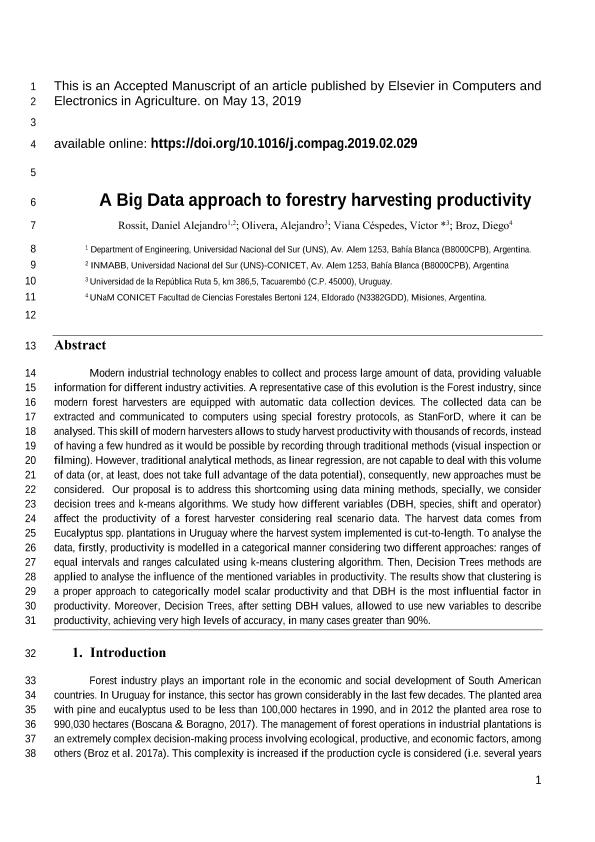Mostrar el registro sencillo del ítem
dc.contributor.author
Rossit, Daniel Alejandro

dc.contributor.author
Olivera, Alejandro
dc.contributor.author
Viana Céspedes, Víctor
dc.contributor.author
Broz, Diego Ricardo

dc.date.available
2020-11-24T13:33:15Z
dc.date.issued
2019-06
dc.identifier.citation
Rossit, Daniel Alejandro; Olivera, Alejandro; Viana Céspedes, Víctor; Broz, Diego Ricardo; A Big Data approach to forestry harvesting productivity; Elsevier; Computers and Eletronics in Agriculture; 161; 6-2019; 29-52
dc.identifier.issn
0168-1699
dc.identifier.uri
http://hdl.handle.net/11336/118819
dc.description.abstract
Modern industrial technology enables to collect and process large amount of data, providing valuable information for different industry activities. A representative case of this evolution is the Forest industry, since modern forest harvesters are equipped with automatic data collection devices. The collected data can be extracted and communicated to computers using special forestry protocols, as StanForD, where it can be analysed. This skill of modern harvesters allows to study harvest productivity with thousands of records, instead of having a few hundred as it would be possible by recording through traditional methods (visual inspection or filming). However, traditional analytical methods, as linear regression, are not capable to deal with this volume of data (or, at least, does not take full advantage of the data potential), consequently, new approaches must be considered. Our proposal is to address this shortcoming using data mining methods, specially, we consider decision trees and k-means algorithms. We study how different variables (DBH, species, shift and operator) affect the productivity of a forest harvester considering real scenario data. The harvest data comes from Eucalyptus spp. plantations in Uruguay where the harvest system implemented is cut-to-length. To analyse the data, firstly, productivity is modelled in a categorical manner considering two different approaches: ranges of equal intervals and ranges calculated using k-means clustering algorithm. Then, Decision Trees methods are applied to analyse the influence of the mentioned variables in productivity. The results show that clustering is a proper approach to categorically model scalar productivity and that DBH is the most influential factor in productivity. Moreover, Decision Trees, after setting DBH values, allowed to use new variables to describe productivity, achieving very high levels of accuracy, in many cases greater than 90%.
dc.format
application/pdf
dc.language.iso
eng
dc.publisher
Elsevier

dc.rights
info:eu-repo/semantics/openAccess
dc.rights.uri
https://creativecommons.org/licenses/by-nc-sa/2.5/ar/
dc.subject
DATA SCINCE
dc.subject
FOREST HARVEST
dc.subject
DECISION MAKING
dc.subject
FOREST ENGINEERING
dc.subject.classification
Silvicultura

dc.subject.classification
Agricultura, Silvicultura y Pesca

dc.subject.classification
CIENCIAS AGRÍCOLAS

dc.title
A Big Data approach to forestry harvesting productivity
dc.type
info:eu-repo/semantics/article
dc.type
info:ar-repo/semantics/artículo
dc.type
info:eu-repo/semantics/publishedVersion
dc.date.updated
2020-11-18T17:04:12Z
dc.journal.volume
161
dc.journal.pagination
29-52
dc.journal.pais
Países Bajos

dc.journal.ciudad
Amsterdam
dc.description.fil
Fil: Rossit, Daniel Alejandro. Consejo Nacional de Investigaciones Científicas y Técnicas. Centro Científico Tecnológico Conicet - Bahía Blanca. Instituto de Matemática Bahía Blanca. Universidad Nacional del Sur. Departamento de Matemática. Instituto de Matemática Bahía Blanca; Argentina
dc.description.fil
Fil: Olivera, Alejandro. Universidad de la República; Uruguay
dc.description.fil
Fil: Viana Céspedes, Víctor. Universidad de la Republica; Uruguay
dc.description.fil
Fil: Broz, Diego Ricardo. Universidad Nacional de Misiones; Argentina. Consejo Nacional de Investigaciones Científicas y Técnicas. Centro Científico Tecnológico Conicet - Nordeste; Argentina
dc.journal.title
Computers and Eletronics in Agriculture

dc.relation.alternativeid
info:eu-repo/semantics/altIdentifier/doi/http://dx.doi.org/10.1016/j.compag.2019.02.029
dc.relation.alternativeid
info:eu-repo/semantics/altIdentifier/url/https://www.sciencedirect.com/science/article/abs/pii/S0168169917316368
Archivos asociados
